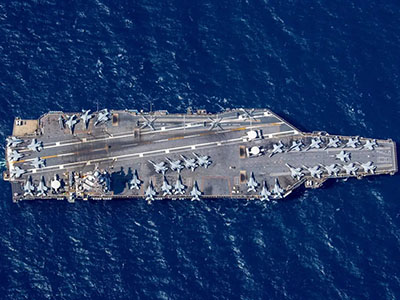Special to WorldTribune.com
 By John J. Metzler, November 10, 2023
By John J. Metzler, November 10, 2023
In the game of baseball, the defending team must cover all bases; First, Second and Third. No matter how good and fast a player is, one person “Can’t cover all bases,” as the expression goes. Cover one and the ball would be hit to another. You need three players to Cover First, Second and Third base. The best and most competent player can’t successfully cover all three dispersed bases. That’s common sense.
So too with growing global U.S. Navy commitments. The Navy, while modern and very competent, is increasingly stretched to cover all contingencies; Not just the 88 feet between baseball bases but commitments and crises as far flung as the Mediterranean Sea, to the Persian Gulf and the wider Pacific.
Because of amazing readiness, the Navy can quickly respond to a crisis. Right now, a Carrier strike group led by the Eisenhower transited the Mediterranean into the Red Sea. The vessels join American ships on patrol near the Persian Gulf protecting the petroleum jugular vein for the USA and its allies coming from the Middle East.
Back in the late 1980’s one of the key points of President Ronald Reagan’s strategy of defense and deterrence was the creation of the 600 ship Navy, it actually reached 594 ships! The U.S. attained the capacity to contain the former Soviet fleet and manage crises and contingencies worldwide.

Currently the U.S. Navy only has 291 ships! Nonetheless the military and deterrence missions have dramatically expanded but the size of the Navy has almost halved in a generation. This is largely due to the former Obama Administration’s cutting of funding for new vessels and the “Pivot to Asia” expanding military commitments.
The world has not become any smaller, but the mission of the Navy has correspondingly grown while the available force deployment of the Fleet has diminished.
Naturally critics will rationalize that today’s ships are better than many of the older vessels retired in the 1990’s and 2000’s. Indeed technology gives a decisive edge to many of the new Carriers, Cruisers and fleet components. But to state the obvious no matter the quality and operational capacity of the ships, the reality of geographic distance, space and speed restrains quick deployments.
Do we have enough When and Where we need them?
Former Secretary of the Navy John Lehman who served in the Reagan Administration wrote a decade ago, “Numbers still count; The seas are great, and our Navy is small.” He added, “Naval readiness is already highly fragile.” In order to meet current operational requirements, he added, the smaller fleet stays deployed longer and gets repaired less.
Today the Chief of Naval Operations/Navigation Plan 2022 states, “This is a critical decade. As global challengers rise to threaten U.S. interests, America must maintain maritime dominance.”
The Sixth Fleet in the Mediterranean Sea remains poised to intervene in a Middle East flareup or war, be it the 1973 Yom Kippur War to the current war Hamas unleashed on Israel from Gaza.
Related: U.S. guided missile destroyer sails through Taiwan Strait during major China exercise, November 7, 2023
Today according to the Naval Institute News, the Carrier “USS Gerald R. Ford and its escorts are underway in the Eastern Mediterranean Sea… The Carrier Strike Group’s presence in the Eastern Mediterranean is meant to deter Hezbollah, Iran, and other actors from joining the war between Hamas and Israel.”
Beyond the Middle East flashpoint, there’s a clear and present danger from China’s expanding naval deployments. The U.S. base in Sasebo Japan, home of the Seventh Fleet and the Carrier group USS Ronald Reagan, home ported in the massive Yokosuka, Japan port remain a mighty and serious deterrence to Beijing’s ambitions towards Taiwan or the disputed South China Sea. Moreover, the USS Carl Vinson, operates in the sensitive East China Sea.
|
Back in the late 1980’s one of the key points of President Ronald Reagan’s strategy of defense and deterrence was the creation of the 600 ship Navy, it actually reached 594 ships! Currently the U.S. Navy only has 291 ships. |
Just recently the U.S. guided missile Destroyer Dewey completed a Freedom of Navigation Operation near the Spratly islands. The transit came a day after USS destroyer Rafael Peralta and Royal Canadian Navy Halifax-class frigate HMCS Ottawa conducted a Taiwan Strait transit. The vessels were shadowed by communist Chinese aircraft and warships. The mission is to show the flag and exercise right of passage in international waters.
Taiwan’s Ministry of Defense stated that communist China’s Carrier Shandong and escorts have been sailing east of Taiwan. Equally Chinese warplanes regularly fly into and harass Taiwan’s sovereign airspace.
Beyond the growing threat posed by Beijing’s People’s Liberation Army/Navy, there’s the very probable contingency of an impending North Korean crisis.
Maintaining credible readiness remains challenging especially when you have to cover all bases.
John J. Metzler is a United Nations correspondent covering diplomatic and defense issues. He is the author of Divided Dynamism the Diplomacy of Separated Nations: Germany, Korea, China (2014). [See pre-2011 Archives]
